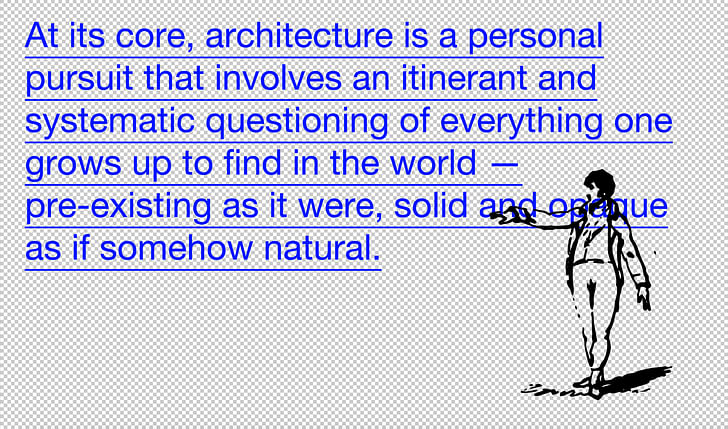

At its core, architecture is a personal pursuit that involves an itinerant and systematic questioning of everything one grows up to find in the world—pre-existing as it were, solid and opaque as if somehow natural.
How, for instance, to a child, an uncle might seem to exist as a specific form of the Platonic Ideal of Uncle. It’s only when growing up that the child realizes the uncle is a real person who once rode a motorcycle, did drugs, had hair, etc.
In a similar mode, we know that the pot-holed asphalt street outside doesn’t just lie there innocently. It is part of a larger Jeffersonian Grid imbued with its own histories, ideologies, and cultural baggage that continue to color imperceptibly the specific way we exist in, and move through, the world today.
That is, the decisions and physical creations of people who have gone before (mostly white men, yes) are what largely structure the world we live in. We can understand these structures, like Jefferson’s Grid, as personal projects that became structural.
Part of growing up in the world, especially as an architect, means either to accept that structure or to work against what is no longer relevant. It seems that this may be an opportune moment to reconsider the models under which the dominant architectural pedagogies are structured.
Can we conceive of other models for architectural practice and education not based on visual styles or characteristics?
It’s a funny thing about architectural education. Pedagogical projects can exist for years in the discipline, not because they necessarily produce good architects, or good architecture. Rather, they produce the conditions under which many students can work on a singular general project while simultaneously developing sufficiently differentiated individual projects. It’s a problem uniquely suited to pedagogy.
What are the dominant models for architectural education then? Those names that still linger above: Zaha, Rem, Thom, Peter, Frank, et al. who built projects on the back of modernism, managing to find the latent potential hidden in the forgotten corners of that great white room.
Do we continue to model our education and our practices after theirs?
In 1960, Reyner Banham famously ended Theory and Design of the First Machine Age with the admonition that architects who wish to keep up with technology might have to leave behind old ideas of what constitutes an architect in order to do so. Today, (wherever we are—the Second Internet Age? Third? Web 3.0 yes?) this has never been more true. Where the spaces we inhabit are more and more in other realities (in screens, and in virtual and augmented realities), do architects have a role in designing other types of space?
Can we conceive of other models for architectural practice and education not based on visual styles or characteristics?
Cross-Talk is a new recurring series on Archinect that endeavors to bring architectural polemics and debate up-to-date and up-to-speed with the pace of cultural production today. Each installation will feature four responses by four writers to a single topic. For this week's iteration, the topic is 'pedagogy'.
Patrick is a Los Angeles-based designer, writer, and educator. He has practiced architecture in Los Angeles and at Sea Ranch, and has taught design studios at SCI-Arc. He currently teaches at the Woodbury University School of Architecture. As a contributor to Archinect, he has written Under ...
2 Comments
At its core, architecture is a personal pursuit that involves an itinerant and systematic questioning of everything one grows up to find in the world—pre-existing as it were, solid and opaque as if somehow natural
Can the author expand on this statement? It is seductive rather than meaningful
Why is it a "personal" pursuit? Is that not already a conceit?
Block this user
Are you sure you want to block this user and hide all related comments throughout the site?
Archinect
This is your first comment on Archinect. Your comment will be visible once approved.